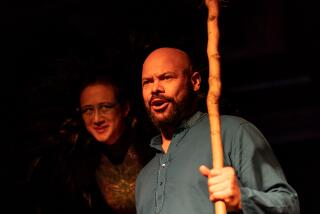Movie Reviews : ‘Flame’ Burns With Yearning for a Lost Past
- Share via
Sa’ied Ebrahimifar’s “Nar ‘O Nay” (at the Monica 4-Plex), which translates from Farsi as “The Flame of the Pomegranate in the Cane,” is a poetic masterpiece, its images as sensitively colored and exquisitely composed as the finest, subtlest of Persian rugs. It evokes powerfully the all-but-vanished leisurely and beautiful way of life of old Persia. Although the film is suffused with longing for a lost past it is not merely an exercise in nostalgia but a powerful expression of how a sense of beauty can sustain an individual through life’s losses and vicissitudes.
This 1988 Iranian production opens in a grim-looking present, with a photographer (Jahangir Almasi) finding an elderly man near death in the street and taking him to a hospital. In trying to establish his identity and contact any relatives, the photographer comes across the man’s notebook. It is no less than a memoir in poetic form, and as the photographer commences reading it we are swept up into the past, taken into an idyllic--and surely privileged--world of a spacious country estate of beauty and simplicity that is surrounded by groves of pomegranate trees. We now meet the elderly, dying man as a small boy being taught calligraphy by his father.
As the chronicle of his life unfolds we do not get to know him in the conventional sense. Instead, Ebrahimifar concerns himself observing the world in which this individual, Kamali (who as an adult is also played by Almasi, an actor who suggests much held in reserve) lives his life.
As we see Kamali, who grows up to be a poet and a teacher, lose his father as a boy and then his own young wife, Ebrahimifar and his masterful cinematographer, Homayoun Paayvar, record such phenomena as the way a corridor is flooded with light with the opening of the door or how beautiful is the effect of flowers tossed on a patio reflecting pool.
Every frame in the flashback section of the film could be extracted as a splendid still life.
None of this is precious, which is the way it may sound, because it becomes increasingly clear that the entire flashback, which constitutes more than 90% of the film, is an expression of Kamali’s own vision as a poet--that this is what got him through a life beset by increasing loss.
The film never refers to the tumultuous times through which Kamali lived--the 1925 fall of the Qajar shahs, the overthrow of the Pahlevi shah by the Ayotollah Khomeini--but instead gives us a sense of the aesthetic inner resources that enabled Kamali to survive them as well as his personal disappointments.
In a wonderfully fitting final touch “Nar ‘O Nay” (Times-rated Mature for complex style and themes) leaves us with a sense of the eternal cycle of life and death--and with a subtle, consoling intimation of reincarnation.
‘Nar ‘O Nay’
Jahangir Almasi: Photographer/the young Kamali
Ghazal Elmi: Mina, Kamali’s daughter
Ali Asghar Garmsiri: the elderly Kamali
Rasoul Najafian: Kamali’s father
A Behzad Zandinejad presentation. Director Sa’ied Ebrahimifar. Producers Ebrahimifar, Hossein Irie. Screenplay by Ebrahimifar, Irie, Aziz Tarseh. Cinematographer Homayoun Paayvar. Editor Zhila Ipakchi. Music Fariborz Latchini. Art director Kayhan Mortazavi. Sound Behrouz Mo’avenian, Asghar Shahverdi. In Farsi, with English subtitles. Running time: 1 hour, 30 minutes.
Times-rated: Mature (for complex style and themes).
More to Read
Only good movies
Get the Indie Focus newsletter, Mark Olsen's weekly guide to the world of cinema.
You may occasionally receive promotional content from the Los Angeles Times.







